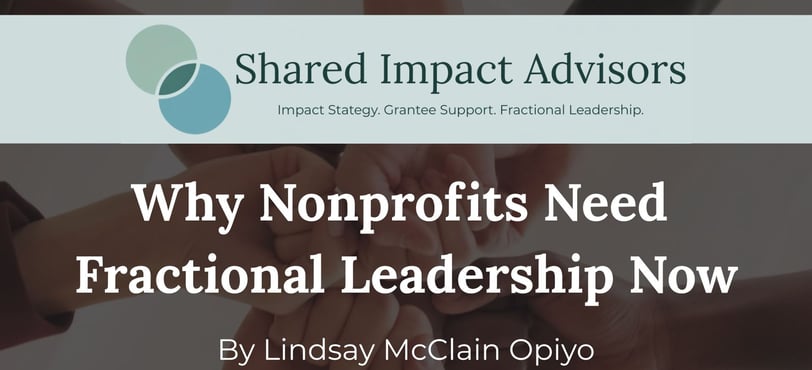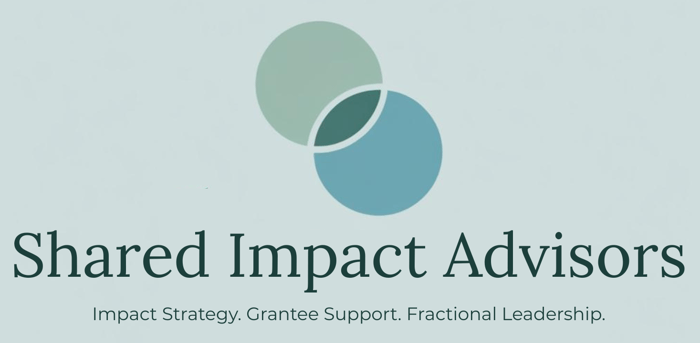Why Nonprofits Need Fractional Leadership Now
Learn how fractional leadership helps nonprofits gain executive expertise during transitions, growth, and change—without the cost of full-time hires.
Lindsay McClain Opiyo
5/29/20253 min read


It’s a tough time for nonprofit leaders.
Federal funding streams are shrinking or delayed. Private funders are shifting priorities. Nonprofit tax classifications and charitable deduction laws are under scrutiny, casting new uncertainty over future philanthropic giving. Meanwhile, the communities we serve are facing rising threats — to safety, to belonging, to basic rights and resources. And internal teams are stretched thin, navigating turnover, burnout, and the same economic pressures everyone else is.
If you’re leading a nonprofit or sitting on a board right now, you’re being asked to do more with less, while staying steady in a constantly shifting environment. The stakes are high, and the margin for error is razor-thin.
This moment calls for something different — and in many cases, fractional leadership might be exactly what’s needed.
What Is Fractional Leadership?
Fractional leadership brings seasoned, executive-level talent into your organization on a part-time or interim basis.
Unlike a consultant who offers external advice, fractional leaders step in as part of your team. They take ownership of specific functions — operations, strategy, programs, development — and lead them forward as embedded executives, not just advisors.
It’s also different from hiring full-time. You get the leadership capacity you need — without having to commit to a permanent hire before you’re ready. That means you can stabilize a transition, move forward on critical initiatives, or scale up with a leaner investment of time and resources.
What Does a Fractional Engagement Look Like?
Fractional leadership is flexible by design. Most engagements last 3 to 12 months, with leaders typically committing 8 to 20 hours per week — enough to drive strategy, manage systems or teams, and provide hands-on leadership, without requiring a full-time salary or benefits.
Some nonprofits use fractional support as a long-term staffing strategy. Others use it as a bridge during transitions, growth periods, or leadership gaps. Whether the role evolves into a full-time position or stays fractional, the goal is the same: bring the right leadership, at the right time, to move your mission forward.
When Fractional Leadership Might Be the Right Next Move
Here are five common reasons nonprofits turn to fractional leadership:
You can’t afford a full-time hire (yet). Whether due to budget cuts or early-stage growth, you may not be ready to take on a full-time executive. Fractional support brings senior-level leadership at a sustainable cost.
You’re growing — and advice isn’t enough. You’ve moved beyond the point where strategic input alone is helpful. You need someone who can roll up their sleeves and execute. That’s what fractional leaders do.
You want to “try before you buy.” If you’re exploring a new function or rethinking your org chart, fractional leadership lets you test structure, fit, and direction before making a full-time commitment.
You’re in a leadership transition. If your ED, COO, or senior leader has moved on, fractional leadership provides continuity and momentum — and buys you time for a thoughtful search.
You’re building the plane while flying it. Rapid growth often outpaces systems and infrastructure. A fractional leader helps you build what’s missing — from ops to board development — so you can sustain what you’ve started.
What to Look for in a Fractional Leader
A great fractional leader isn’t just a skilled consultant — they’re a strategic partner who can lead from within. Here’s what to look for:
Values alignment. They should understand your context and share your values — not just show up with a playbook.
Cross-functional experience. You want someone who’s worked across functions and can quickly spot — and solve — gaps in strategy, systems, or team dynamics.
Execution and facilitation skills. You need not just planners, but doers. You need a builder. Fractional leaders move from vision to action, align teams, and get things done.
Influential leadership. Especially in part-time roles, the ability to build quickly trust and lead — sometimes without formal power — is critical.
Calm in the chaos. Your fractional partner should bring structure to ambiguity and adapt as things evolve — offering clarity and confidence when you need it most.
A New Way Forward
For boards and executives seeking to build sustainable, community-centered organizations, fractional leadership is more than a stopgap — it’s a strategic move.
At Shared Impact Advisors, we provide fractional and interim leadership to funders and social impact organizations during moments of transition or growth. We've walked in your shoes — as nonprofit executives, fundraisers, program leads, and board members — and we know what it takes to turn complexity into clarity and action.
Let’s Talk
Curious whether fractional leadership could help your organization move forward to the next phase? We offer free consultations and would love to learn more about what you’re building.
🔗 Send us a message at Shared Impact Advisors or email us at info@sharedimpactadvisors.com.
This article was originally was published on LinkedIn at https://www.linkedin.com/pulse/why-nonprofits-need-fractional-leadership-now-lindsay-mcclain-opiyo-30iqe.


